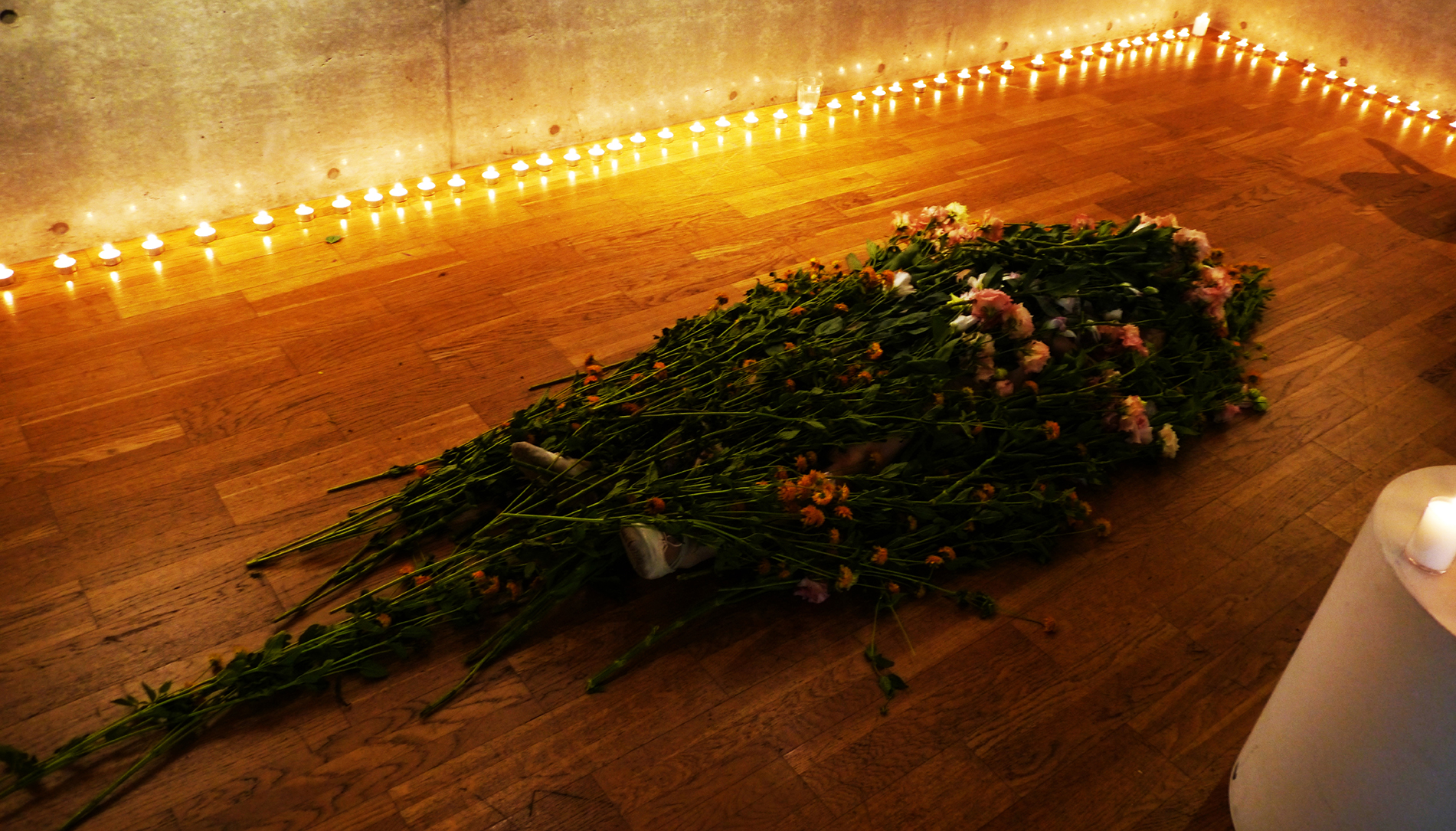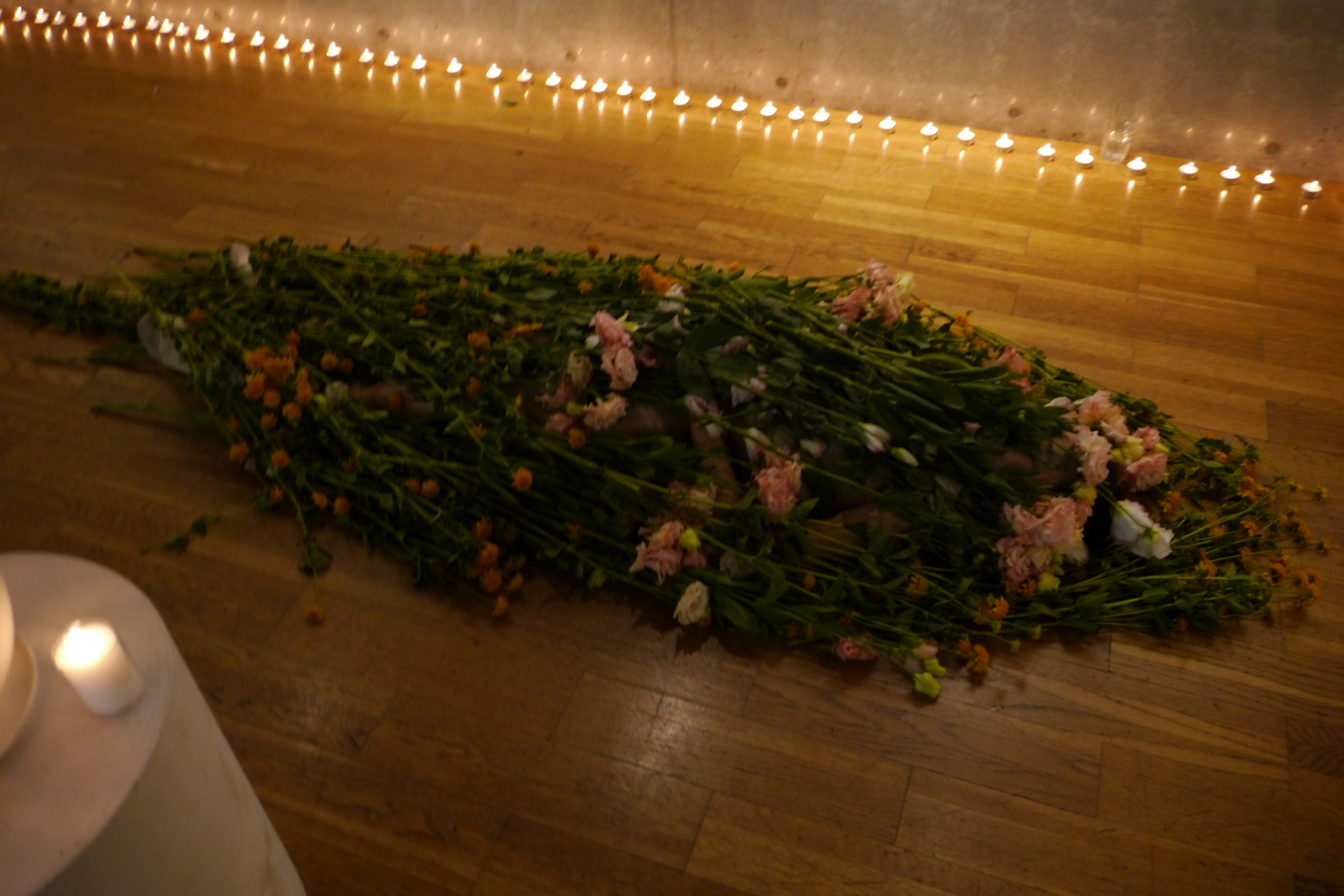performance, July 2014
Gallery Brocken, Tokyo, Japan
I explore a theme on public mourning for the death prohibited to mourn.
In this piece, the death mourned was in relation to the mass famine in North Korea since the late 1990s.
According to Jean Baudrillard, a key element of the revolution of modernity is how it transforms our relation to the dead. The dead in traditional societies are not only revered as ancestors but also held up as role models, as ideals for the living to follow. But modern people consider themselves free and want to be themselves. They reject the ideals of the past, or the claims of the dead because they think it will force them to become someone other than who they are. But the modern idea of freedom defines freedom as empty, so most people end up in a vicious circle where they want to be themselves, but have no idea of what it means to be one’s self.
I attempt to reintroduce an indigenous function of ritual for death through my art practice with a contemporary interpretation.
——————————————————————————
I invited the audience to pray unconditionally for those who are killed and those who are killed,
for those who are injured and those who gave injury.
——————————————————————————
Click the play button ▶︎ to view in autoplay mode. Or you can directly click on the image to advance to the next images.
Since the Korean War has not ended officially, lead Korea remained as two separate countries. The truth fact-finding of millions of civilian massacres was not fully revealed yet. Many dead spirits were not properly mourned publicly as well as privately. There are many taboos in relation to the massacre due to the regime policy using state violence through both South and North Korean governments, prolonged. People were not even allowed to speak about it for a long time until quite recently. Many deaths in North Korea were unconsciously considered to be undeserving of mourning because of people’s hatred toward the North Korean government.
That anonymous death unmourned keeps reappearing as a pattern, inducing other sorts of tragedy. In North Korea, an estimated up to three million people were starved since the mid-1990s.
<contents of the video, screened in the performance>
During Japanese colonialism, many Koreans immigrated to Japan.
Koreans were enslaved as labor forces, some were enlisted as Japanese soldiers and forced to sacrifice their lives for invading Asia Pacific regions.
They were living under the condition of severe poverty.
Discrimination against Koreans was almost unbearable to many, since 1959, they started to immigrate to North Korea. They are called “returners” as they were considered to return to their mother country.
However many of them were from the Southern part of Korea and they immigrated to totally unfamiliar territory.
A total of over 90,000 “returners” immigrated to North Korea and the immigration plan was ended in 1984.
After a while, many “returners” were executed and sent to concentration camps. Many already died.
In recent years, some of the “returners” escaped from North Korea and immigrated to China, South Korea, and Japan.
I moved to South Korea from Japan in 2011.
After a while, my mother told me that my great grandfather died in North Korea.
I met some of the “returners” residing in South Korea and heard stories of their lives.
During the performance, the video piece including my conversation with “returners” was screened with the images of the ocean.
In the conversation, the story of starvation from the late 1990s till the beginning of 2000 was talked about. He witnessed many of his neighbors die one after another. Death became a daily matter, he did not fear it. Since he was working as a doctor, he needed to bury the remains of children. The official number of starved population was estimated as three million. Even though he cannot believe this number, he thinks it would not be an exaggeration. Horrifying scenery of mass starvation was told through his voice.
performance documentation, 5min
*The video can be watched with a donation-based contribution.
Please make an inquiry via the contact page.
interview video, 23min full length
*Please inquire about the password to view the video through the contact page.
タイトル: 「天国の門」 和解編
1959年より多くの在日朝鮮人たちが北朝鮮への「帰国」した。
「帰国者」のほとんどは南半部の朝鮮、韓国出身の人たちだった。
のべ9万人にものぼる「帰国者」を乗せた帰国事業は1984年に集結した。
「帰国者」多くは粛正され、収容所へ送られ、他界した。
「帰国者」なかで、北朝鮮を逃れ中国、韓国、日本へ移住してきた人がいる。
私は韓国2011年春から韓国に住み始め、たくさんの「帰国者」が韓国に住んでいることを知ることになった。
地上の楽園を夢見て 多くの帰国者が行き着いた先は 天国の入り口であった。
多くの魂達は、既にもうその門をくぐって あちら側に越えて行った。
大丈夫 安心して
そこは本当に天国の門だから。
今度こそは本当に自由になるから
安心してその川を渡ってね。
地上での惨状は
文字通り 天国への入り口だった。
彼らは地上での苦しみから 解き放たれ、 光へ戻って行った。


























